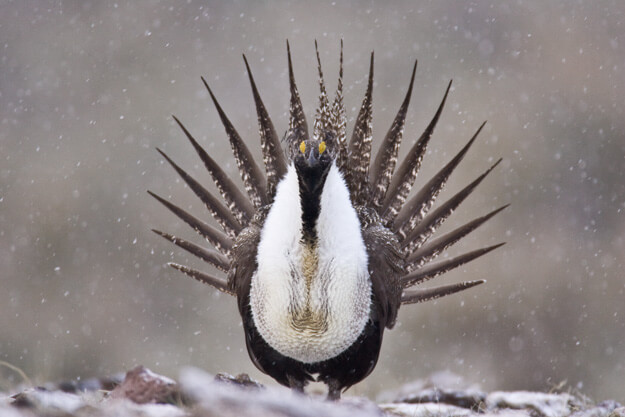Wind Power Could Kill Millions of Birds Annually by 2030
For Immediate Release Contact: 202-234-7181 ext. 210
 |
Greater Sage-Grouse. Photo: Noppadol Paothong |
(Washington, D.C., February 2, 2011)
- Department of the Interior to issue wind and wildlife guidelines imminently
- Congressional hearing requested by conservationists
- Major Department of Interior meeting on renewable energy scheduled for February
9-10 will address issue
American Bird Conservancy (ABC), the nation's leading bird conservation organization, said today that the build-out of wind energy proposed by the federal government to meet a Department of Energy target of generating 20% of the nation's electricity through wind power is expected to kill at least one million birds per year by 2030, and probably significantly more.
ABC considers the one million estimate, which is based on a 2005 paper1 and widely cited by the wind industry, as likely a significant underestimate of bird mortality. For example, a more recent 2009 estimate by the U.S. Fish and Wildlife Service (FWS) indicated that approximately 440,000 birds were already being killed per year2. At the time, 22,000 turbines were in operation representing 25GW of installed capacity, a fraction of the 300GW of production capacity needed to meet the 20% by 2030 target. Wind farms are also expected to impact almost 20,000 square miles of terrestrial habitat, and over 4,000 square miles of marine habitat by 2030, some of this critical to threatened species.
“The real answer is that we simply don't yet have enough data to reliably estimate cumulative impacts, but once acquired they will likely far exceed current estimates. The growing and disproportionate 'take' of species of conservation concern also appears to be an issue relative to the overall number of birds killed, and that is another cause for worry,” stated Dr. Albert Manville of the FWS's Division of Migratory Bird Management.
“We are plunging head-long into wind power, but so far, very few studies have been conducted that show what scale of impact it will really have on birds,” said Mike Parr, ABC's Vice President. “While American Bird Conservancy supports bird-smart wind power, we do not support the fast-tracking of wind projects without adequate environmental oversight or assessment that can help developers and the public be certain that significant numbers of birds will not be harmed.”
In the near future, the Department of the Interior is expected to issue industry guidelines on the siting and operation of wind power to reduce bird and other wildlife impacts. Whether these guidelines will be binding or not is a cause of major concern to conservationists. “We wouldn't allow stop signs to be voluntary, so why would preventing the killing of birds, which violates the Migratory Bird Treaty Act, be voluntary?” said ABC's Vice President of Conservation Advocacy, Darin Schroeder.
Another major concern about wind development is that certain sensitive species may be affected very significantly by wind build-out. These include the spectacular Golden Eagle, the declining Greater Sage-Grouse, and endangered species such as the Whooping Crane. These species can be impacted by transmission lines and the infrastructure associated with wind farms, or by the turbines themselves.
In addition, today, American Bird Conservancy requested a Congressional hearing to investigate the scale and impact of bird kills caused by wind energy. “The impacts to birds from wind power have gone unrecognized and unaddressed, and are wrongly dismissed by industry as insignificant. In the light of the rapid growth in the industry to meet federal renewable energy targets, ABC is requesting a Congressional hearing into the bird impacts of wind power,” added Schroeder. “ABC supports bird-smart wind power, but without strong federal standards protecting birds, we fear a major, on-going new threat will be created. We still have time to get it right if we act now,” he stated.
A major Department of the Interior meeting is scheduled for next week to address a series of issues regarding renewable energy, including the impact of wind farms on birds and other wildlife.
1 Based on mortality estimates in Erickson, Wallace P., Johnson, Gregory D and Young Jr., David P. (2005). A Summary and Comparison of Bird Mortality from Anthropogenic Causes with an Emphasis on Collisions. USDA Forest Service Gen. Tech. Rep. PSW-GTR-191, pp 1029-1042.
2 The 440,000 estimate corrects for biases regarding: inconsistencies in duration and intensity of searches; size of the search plots; failure to estimate mortality during the peak periods of migration, or during some migration periods at all; impacts from wind wake and blade tip vortices; biases from unaccounted crippling losses; and the possibility of mass mortality events where nighttime migration coincides with inclement weather, that are not typically addressed or corrected for by existing studies.
American Bird Conservancy conserves native birds and their habitats throughout the Americas by safeguarding the rarest species, protecting and restoring habitats, and reducing threats while building capacity of the bird conservation movement. For more information, visit, www.abcbirds.org


















































